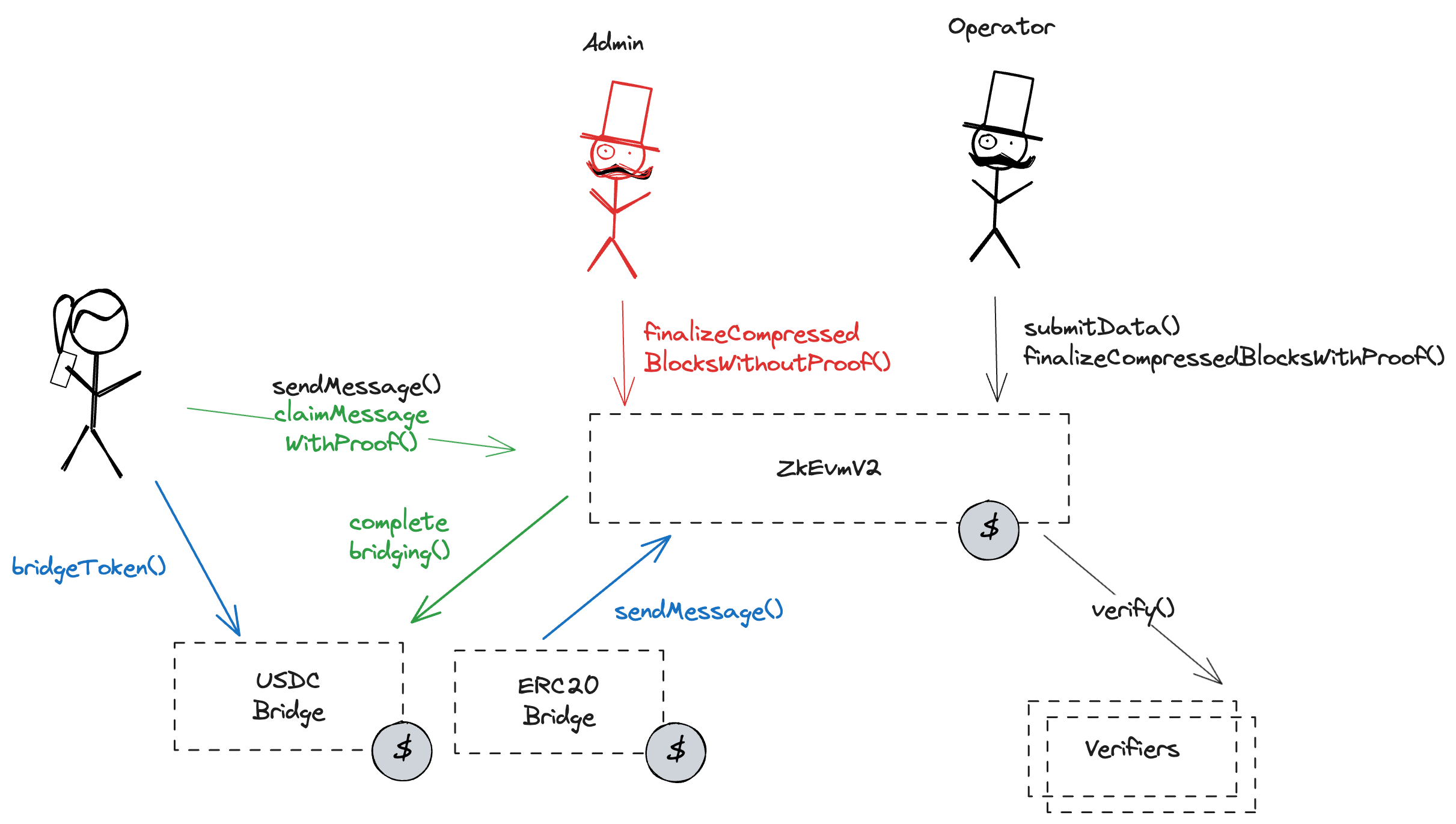 Linea
Linea
Badges
About
Linea is a ZK Rollup powered by a zkEVM developed at Consensys, designed to scale the Ethereum network.
Badges
About
Linea is a ZK Rollup powered by a zkEVM developed at Consensys, designed to scale the Ethereum network.
Recategorisation
The project will be classified as "Other" due to its specific risks that set it apart from the standard classifications.
The project will move to Others because:
Consequence: projects without a proper proof system fully rely on single entities to safely update the state. A malicious proposer can finalize an invalid state, which can cause loss of funds.
2024 Mar 14 — 2025 Mar 14
2024 Mar 14 — 2025 Mar 13
The section shows the operating costs that L2s pay to Ethereum.
2024 Mar 14 — 2025 Mar 13
Funds can be stolen if
Funds can be frozen if
Users can be censored if
MEV can be extracted if
Sequencer failure
No mechanismState validation
ZK proofs (SN)SNARKs are zero knowledge proofs that ensure state correctness, but require trusted setup.
Data availability
OnchainAll of the data needed for proof construction is published on Ethereum L1. Unlike most ZK rollups, transaction data is posted instead of state diffs.
Exit window
NoneThere is no window for users to exit in case of an unwanted regular upgrade since contracts are instantly upgradable.
Proposer failure
Cannot withdrawOnly the whitelisted proposers can publish state roots on L1, so in the event of failure the withdrawals are frozen. Eventually (after 6 months of no finalized blocks) the Operator role becomes public, theoretically allowing anyone to propose state with valid proofs.
Validity proofs ensure state correctness
Each update to the system state must be accompanied by a ZK proof that ensures that the new state was derived by correctly applying a series of valid user transactions to the previous state. These proofs are then verified on Ethereum by a smart contract.
Zero knowledge SNARK cryptography is used
Despite their production use zkSNARKs are still new and experimental cryptography. Cryptography has made a lot of advancements in the recent years but all cryptographic solutions rely on time to prove their security. In addition zkSNARKs require a trusted setup to operate.
Funds can be stolen if the cryptography is broken or implemented incorrectly.
All data required for proofs is published on chain
All the data that is used to construct the system state is published on chain in the form of cheap blobs or calldata. This ensures that it will be available for enough time.
Each update to the system state must be accompanied by a ZK proof that ensures that the new state was derived by correctly applying a series of valid user transactions to the previous state. These proofs are then verified on Ethereum by a smart contract.
The source code of the prover is currently not public.
The source code of the circuits is currently not public.
Funds can be stolen if the prover is able to generate false proofs.
Given that the circuit is not public, the generation of the verification keys is not public either.
The system has a centralized sequencer
Only a trusted sequencer is allowed to submit transaction batches. A mechanism for users to submit their own batches is currently disabled.
MEV can be extracted if the operator exploits their centralized position and frontruns user transactions.
Funds can be frozen if the sequencer refuses to include an exit transaction (CRITICAL).
Users can't force any transaction
There is no general mechanism to force the sequencer to include the transaction.
Users can be censored if the operator refuses to include their transactions.
Regular messaging
The user initiates L2->L1 messages by submitting a regular transaction on this chain. When the block containing that transaction is settled, the message becomes available for processing on L1. ZK proofs are required to settle blocks. Note that withdrawal requests can be censored by the Sequencer. Currently, there is a general limit of 18750.0 ETH that can be withdrawn within each 1d time window. Users can (eventually, after 6 months of inactivity from the centralized Operator) exit by replacing the Operator. In such a case they need to self-propose and prove their new state on the base layer with the required software which is currently not made available.
Funds can be frozen if the operator censors withdrawal transaction.
Ethereum
Actors:
A Multisig with 4/8 threshold. It uses the following modules: Roles (The Zodiac roles module for Safe multisigs allows defining roles that are allowed to call preconfigured targets on behalf of the Gnosis Safe). Admin of the Linea rollup. Can upgrade all core contracts, bridges and update permissioned actors.
Address allowed to pause the TokenBridge, the USDCBridge and the core functionalities of the project (via LineaRollup contract).
The operators are allowed to prove blocks and post the corresponding transaction data.
Address allowed to pause the ERC20Bridge, the USDCBridge and the core functionalities of the project in the LineaRollup contract (via the Roles module of the LineaAdminMultisig).

Ethereum
The main contract of the Linea zkEVM rollup. Contains state roots, the verifier addresses and manages messages between L1 and the L2. The contract is pausable by LineaAdminMultisig. This contract stores the following tokens: ETH.
Owner of the ProxyAdmin and Verifier Setter. The current delay is 0s.
Currently used smart contract verifying the proofs for the Linea zkEVM.
Contract used to bridge ERC20 tokens. This contract can store any token.
Contract used to bridge USDC tokens. This contract stores the following tokens: USDC.
Value Secured is calculated based on these smart contracts and tokens:
The current deployment carries some associated risks:
Funds can be stolen if a contract receives a malicious code upgrade. There is a 0s delay on code upgrades.